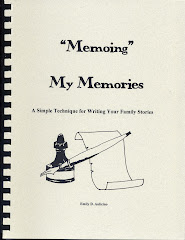Journalists and other technical writers report information to their audiences. They convey information with enough details to get through the facts, fill the required space and appease their editors. Unless the story is “breaking news” for the journalist or the report is required reading by the boss, most of us hit the high spots and move on. Naturally, we do not want our descendants to treat our family stories and childhood memories in that manner.
Like the novelist, the family historian must engage their audience in such a way as to ensure the readers will continue reading the story. The key to all this is to provide enough descriptive detail to entice the reader into caring about the characters and the situation. Descriptive language is used to create images in the reader's mind and to enhance the story. Description must exist as part of the action and emotion of a character. Show how the characters behave and what they think through their actions and emotions. Do not just state (tell) an action or emotion.
And how does one do this?
For most people, the easiest way is to write the memory or family story focusing on the facts of the event, and then revise to add more detail, description, feelings, emotion, etc.
As you revise, it is important to be aware of your intended audience. Other than the facts of the situation, what would your audience like to know about their grandmother or a great-great uncle? Attach personality traits to your characters, but not by just stating that she was a strict person or he was the benevolent peacemaker. Do not tell, but show these traits through the character’s actions. What did great-grandmother do which indicated she was strict? How did others react to her behavior?
While you are revising your writing, notice the boring verbs and nouns. Replace those with exciting nouns and verbs to pull your reader into the story. For example, do not continue to say “my uncle Harry” or “he.” Describe Uncle Harry by referencing one of his traits. Begin a sentence with The old codger or As the peacemaker. These types of phrases not only reveal more about your character, but they alert the reader’s brain into thinking of Uncle Harry as more than just an uncle.
Besides showing what your characters are like, you must attend to the scenery with the same great care. It is easy to say She sat down with a cup of tea to write the letter, but it is much more interesting to describe the hiss of the kettle disrupting the silence and the evening shadows cast by the last light through the window, in order to set the mood of the letter writer in such terms that the reader sees a vivid picture of the scene and feels they are that preverbal “fly on the wall.”
Writing with descriptive evidence helps the reader make determinations about the character’s personality and behavior, thus, helping the reader evaluate that person. Getting the reader involved with the story in this manner entices the reader to move through the story with interest. They are not just reading words; they are getting involved and starting to understand the dynamics of their ancestors’ lives.
Just telling a story does not speak to the imagination of the reader. Every writer wants to be read and will be read if that imagination is sparked.
Remember to show through actions and emotions the characteristics of your ancestors and to paint a picture with your words that will be etched in your reader’s memory.
©aulicino, 23 Oct 2008
Thursday, October 23, 2008
Subscribe to:
Post Comments (Atom)









1 comment:
I've never been a "writer", but now that I'm doing a blog, I find it's time to learn how to write! Thanks for the wonderful suggestions here.
Post a Comment